
A tobacco pipe, often called simply a pipe, is a device specifically made to smoke tobacco. It comprises a chamber for the tobacco from which a thin hollow stem (shank) emerges, ending in a mouthpiece. Pipes can range from very simple machine-made briar models to highly prized hand-made artisanal implements made by renowned pipemakers, which are often very expensive collector's items.

A bong is a filtration device generally used for smoking cannabis, tobacco, or other herbal substances. In the bong shown in the photo, the smoke flows from the lower port on the left to the upper port on the right.

A head shop is a retail outlet specializing in paraphernalia used for consumption of cannabis and tobacco and items related to cannabis culture and related countercultures. They emerged from the hippie counterculture in the late 1960s, and at that time, many of them had close ties to the anti-Vietnam War movement as well as groups in the marijuana legalization movement like LeMar, Amorphia, and the National Organization for the Reform of Marijuana Laws.
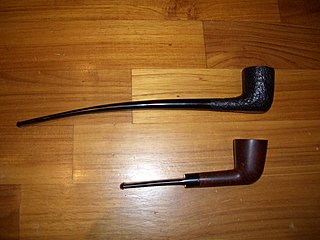
A churchwarden pipe is a tobacco pipe with a long stem. The history of the pipe style is traced to the late eighteenth or early nineteenth century. Some churchwarden pipes can be as long as 16 inches (40 cm). In German the style is referred to as "Lesepfeife" or "reading pipe", presumably because the longer stem allowed an unimpeded view of one's book, and smoke does not form near the reader's eyes, allowing one to look down.

A meerschaum pipe is a smoking pipe made from the mineral sepiolite, also known as meerschaum. Meerschaum is sometimes found floating on the Black Sea and is rather suggestive of sea foam.

Pipe smoking is the practice of tasting the smoke produced by burning a substance, most commonly tobacco or cannabis, in a pipe. It is the oldest traditional form of smoking.

A tobacconist, also called a tobacco shop, a tobacconist's shop or a smoke shop, is a retail business that sells tobacco products in various forms and the related accoutrements, such as pipes, lighters, matches, pipe cleaners, and pipe tampers. More specialized retailers might sell ashtrays, humidification devices, hygrometers, humidors, cigar cutters, and more. Books and magazines, especially ones related to tobacco are commonly offered. Items irrelevant to tobacco such as puzzles, games, figurines, hip flasks, walking sticks, and confectionery are sometimes sold.

A smoking pipe is used to taste the smoke of a burning substance; most common is a tobacco pipe. Pipes are commonly made from briar, heather, corncob, meerschaum, clay, cherry, glass, porcelain, ebonite and acrylic.
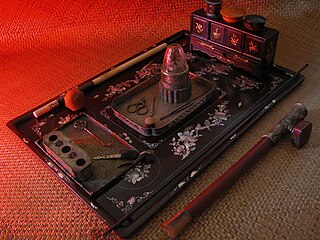
An opium pipe is a pipe designed for the evaporation and inhalation of opium. True opium pipes allow for the opiate to be vaporized while being heated over a special oil lamp known as an opium lamp. It is thought that this manner of "smoking" opium began in the seventeenth century when a special pipe was developed that vaporized opium instead of burning it.

Smoking is a practice in which a substance is combusted and the resulting smoke is typically inhaled to be tasted and absorbed into the bloodstream of a person. Most commonly, the substance used is the dried leaves of the tobacco plant, which have been rolled with a small rectangle of paper into an elongated cylinder called a cigarette. Other forms of smoking include the use of a smoking pipe or a bong.
The Musée du Fumeur is a private museum of smoking located in the 11th arrondissement of Paris at 7 rue Pache, Paris, France. This is a museum founded in 2001 by Michka Seeliger-Chatelain and Tigrane Hadengue. It is open daily except Monday; an admission fee is charged. The nearest métro station is Voltaire.

The history of smoking dates back to as early as 5000 BC in the Americas in shamanistic rituals. With the arrival of the Europeans in the 16th century, the consumption, cultivation, and trading of tobacco quickly spread. The modernization of farming equipment and manufacturing increased the availability of cigarettes following the reconstruction era in the United States. Mass production quickly expanded the scope of consumption, which grew until the scientific controversies of the 1960s, and condemnation in the 1980s.

The Grachtengordel, known in English as the Canal District, is a neighborhood in Amsterdam, Netherlands located in the Centrum district. The seventeenth-century canals of Amsterdam, located in the center of Amsterdam, were added to the UNESCO World Heritage List in August 2010. The Amsterdam Canal District consists of the area around the city's four main canals: the Singel, the Herengracht, the Keizersgracht, and the Prinsengracht. From the Brouwersgracht, the canals are generally parallel with one another, leading gradually southeast into the Amstel river.
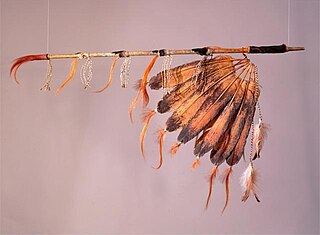
A ceremonial pipe is a particular type of smoking pipe, used by a number of cultures of the indigenous peoples of the Americas in their sacred ceremonies. Traditionally they are used to offer prayers in a religious ceremony, to make a ceremonial commitment, or to seal a covenant or treaty. The pipe ceremony may be a component of a larger ceremony, or held as a sacred ceremony in and of itself. Indigenous peoples of the Americas who use ceremonial pipes have names for them in each culture's Indigenous language. Not all cultures have pipe traditions, and there is no single word for all ceremonial pipes across the hundreds of diverse Native American languages.
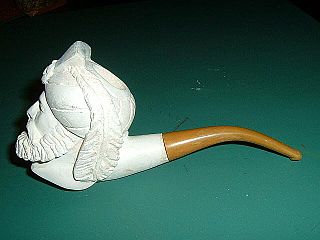
Eskişehir Meerschaum Museum is a handicraft museum in Odunpazarı district of Eskişehir, Turkey, exhibiting various items handmade of sepiolite (Meerschaum).

White pipe clay is a white-firing clay of the sort that is used to make tobacco smoking pipes, which tended to be treated as disposable objects. This suited pipeclay, which is not very strong.
Eduard Bird was an English tobacco pipe maker who spent most of his life in Amsterdam. His life has been reconstructed by analysis of public registers, probate records, and notary and police records, by historians such as Don Duco and Margriet De Roever from the 1970s onwards. Pipes with the "EB" stamp have been found around the world.
The Kennemerland was a Dutch East Indiaman that was lost off the Out Skerries, Shetland, in 1664. It was carrying cargo from the Netherlands to the Dutch East Indies, and had taken the northern route to avoid interception by the English, since the Second Anglo-Dutch War was expected to start soon. There were just three survivors. The islanders salvaged what they could, but there were disputes over ownership of the spoil. The vessel's excavation in the 1970s was one of the earliest exercises in the new discipline of maritime archaeology.

The Macau Scientific and Cultural Centre Museum in Lisbon is Portugal's main museum of Chinese artefacts and artworks. Made to document Sino-Portuguese relations, the museum contains over 3,500 works of art including decorative artwork, costumes, a collection of opium-smoking paraphernalia and an important extensive collection of Chinese ceramics.
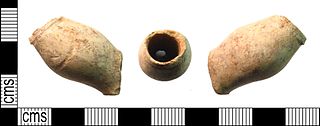
Clay pipe dating is the act of dating clay tobacco pipes found at archaeological sites to specific time periods.
























